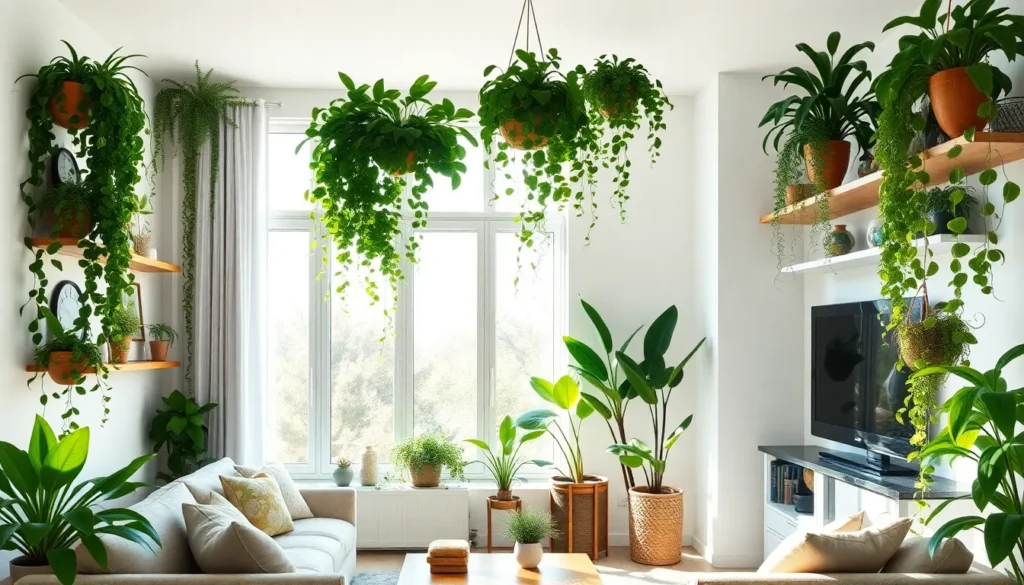Transform your living space into a lush green sanctuary with the magic of indoor vining plants. We’ve discovered that these cascading beauties don’t just purify your air – they create stunning visual drama that turns any room into an Instagram-worthy oasis. Whether you’re dealing with boring blank walls or craving that jungle vibe everyone’s talking about, vining plants offer endless possibilities for creative home styling.
We know you’re tired of the same old houseplant routine. That’s why we’re sharing game-changing ideas that’ll make your friends wonder how you became such a plant styling genius overnight. From trailing pothos that transform empty corners into green waterfalls to climbing philodendrons that create living room dividers, these versatile plants work magic in spaces you never thought possible.
Ready to discover which vining varieties thrive indoors and learn the styling secrets that’ll elevate your home’s aesthetic? Let’s jump into the industry of indoor vine plants that’ll completely revolutionize your space.
Transform Your Living Space With Cascading Greenery
We’ve discovered that strategic placement of vining plants creates dramatic visual impact throughout our homes. Cascading foliage naturally draws the eye upward, making rooms appear larger and more ever-changing than traditional floor-based plant arrangements.
Vertical garden walls become stunning focal points when we mount climbing plants like pothos, philodendrons, and English ivy on trellises or moss poles. These living installations purify air while adding texture and depth to blank wall spaces.
Hanging basket displays maximize our growing space without cluttering floor areas. We position trailing plants such as string of pearls, spider plants, and Boston ferns at varying heights to create layered greenery that flows naturally downward.
Ceiling mounted systems transform unused overhead space into thriving plant sanctuaries. Macrame hangers, pulley systems, and suspended shelving allow us to cultivate multiple vining species while maintaining easy access for care and maintenance.
Room divider applications offer creative answers for open floor plans where we need visual separation without solid barriers. Tall plant stands supporting climbing varieties like monstera deliciosa or rubber plants create natural boundaries that filter light and noise.
Window frame enhancements maximize natural light exposure while creating privacy screens. We train fast-growing vines around window casings, allowing morning glory, jasmine, or grape ivy to frame our views with living architecture.
Staircase transformations use vertical space along railings and beneath steps for dramatic plant displays. Trailing varieties positioned on upper landings cascade down multiple levels, creating waterfall effects that guide movement through our homes.
Corner utilization strategies turn awkward spaces into plant paradise zones. We combine tall climbing plants with shorter trailing varieties to fill vertical corners completely, making previously unused areas become vibrant growing environments.
Choose Low-Maintenance Vining Plants for Beginners
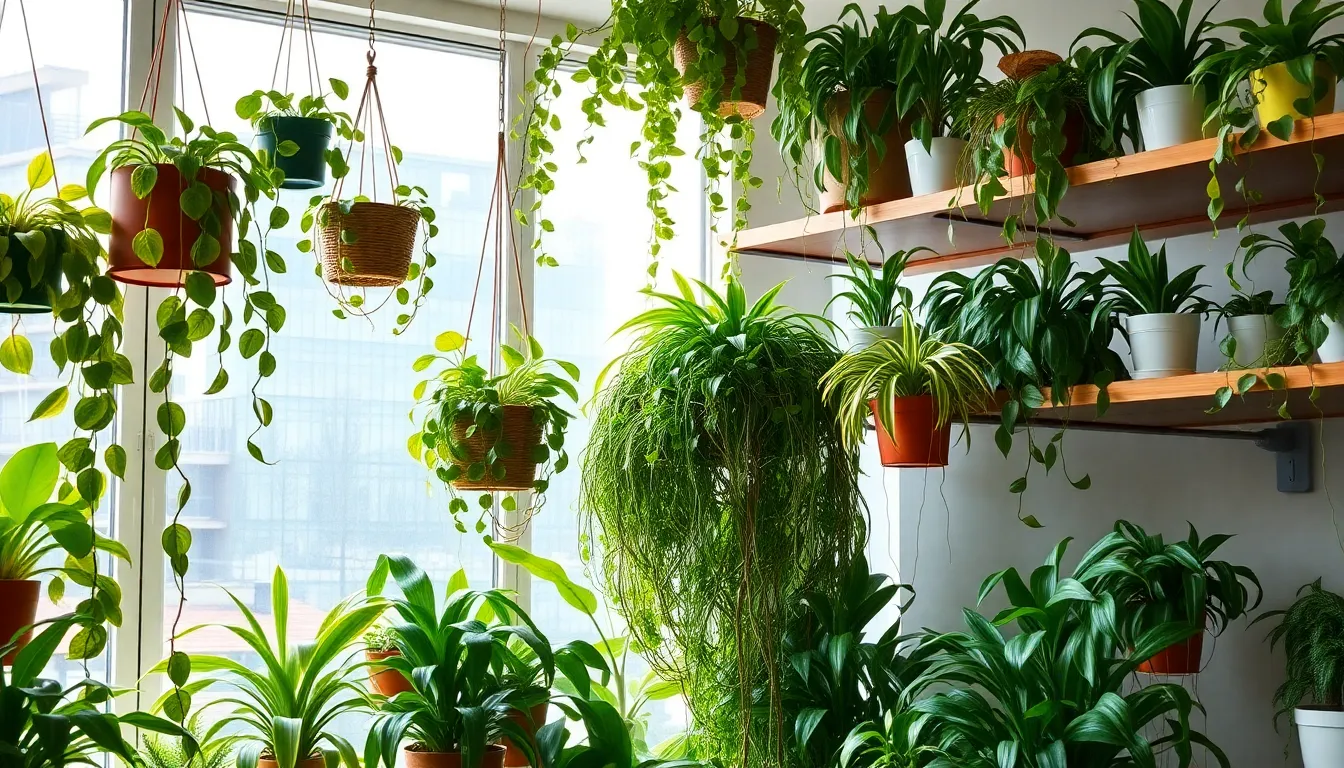
Starting your indoor vining plant journey doesn’t have to be overwhelming. We’ve selected the most forgiving varieties that thrive with minimal attention while delivering maximum visual impact.
Pothos Varieties for Every Room
Golden pothos stands out as the ultimate beginner-friendly vining plant, tolerating everything from dim corners to bright windowsills. These versatile climbers can reach impressive lengths of up to 12 feet, making them perfect for dramatic cascading displays from high shelves or hanging baskets.
Marble queen pothos offers stunning variegated foliage with cream and green patterns that brighten any space. We love how this variety maintains its beautiful coloration even in lower light conditions, unlike many other variegated plants that lose their markings.
Jade pothos provides solid green coverage for those who prefer classic, uniform foliage. This variety grows particularly fast and creates dense, lush displays that work beautifully as living curtains or room dividers.
Regular pruning keeps all pothos varieties manageable and encourages bushier growth patterns. Simply trim back long vines to your desired length, and the plant will respond with new growth from multiple points.
Spider Plant Propagation Benefits
Spider plants produce adorable plantlets naturally on long, arching stems that dangle like tiny green spiders. These “babies” develop their own root systems while still attached to the mother plant, making propagation incredibly simple for beginners.
Rooting spider plant babies requires no special equipment or complicated procedures. We simply place the plantlets in small containers of water until roots develop, then transplant them into soil for new plants.
Free plants multiply your collection effortlessly through this natural propagation process. One mature spider plant can produce dozens of offspring throughout the growing season, giving you plenty to share with friends or expand your own indoor garden.
Sustainability becomes second nature with spider plants since you’ll rarely need to purchase new specimens. The continuous cycle of propagation means your plant collection grows organically without additional investment.
Philodendron Care Essentials
Heart shaped leaves make philodendrons instantly recognizable and beloved among indoor plant enthusiasts. These glossy, often large leaves create bold statements whether cascading from hanging planters or climbing moss poles.
Bright indirect light suits most philodendron varieties perfectly, though they’ll adapt to lower light conditions better than many houseplants. We position ours near east or north facing windows for optimal growth without risk of leaf burn.
Watering becomes intuitive once you learn to check the top inch of soil for dryness. Philodendrons prefer consistent moisture but never soggy conditions, making them forgiving if you occasionally forget a watering session.
Multiple species offer diverse leaf shapes and sizes to match any decorating style. From the compact heartleaf philodendron to the dramatic split leaf varieties, there’s a perfect option for every room and aesthetic preference.
Create Stunning Vertical Gardens With Climbing Plants
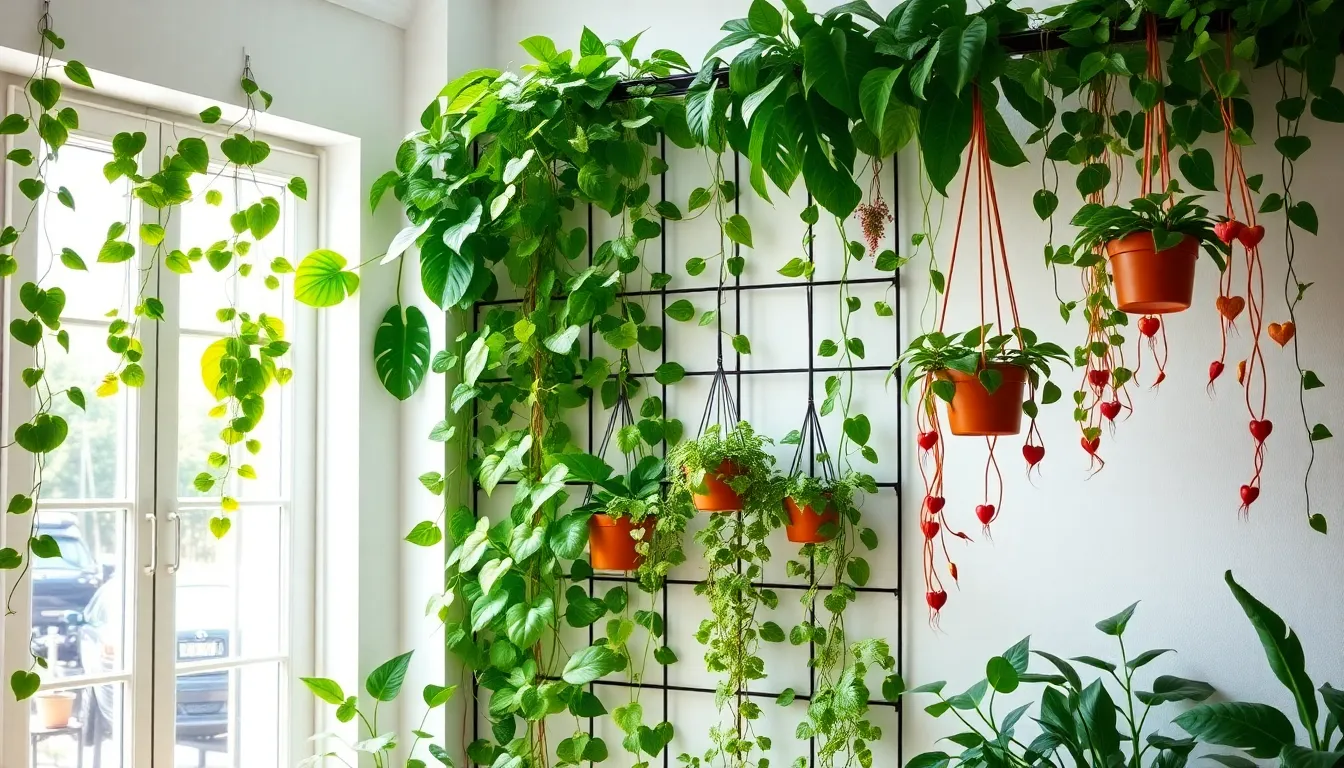
We can transform our indoor spaces into living masterpieces by training vining plants to grow upward using proper support structures. Directing these plants vertically not only mimics their natural climbing habitat but also maximizes our growing space while creating dramatic visual impact.
Monstera Deliciosa Training Techniques
Monstera deliciosa thrives when we provide it with vertical support structures like moss poles or wooden stakes. Installing a sturdy support into the potting soil before planting prevents root damage and gives the plant’s aerial roots a surface to cling to naturally.
Securing the stems loosely to the support with soft clips or twine allows room for natural expansion while guiding upward growth. We should adjust these ties periodically to accommodate the plant’s development and prevent constriction.
Maintaining consistent moisture for both the plant and its moss pole support structure encourages the aerial roots to attach properly. Watering only when the soil surface feels dry prevents overwatering while supporting vigorous climbing behavior.
Regular feeding with nutrient rich organic soil plus occasional liquid fertilizers like seaweed extract promotes the development of larger, fenestrated leaves. Well lit spots provide the adequate sunlight essential for healthy climbing growth patterns.
English Ivy Wall Coverage
English ivy creates stunning living walls through its natural climbing ability using small rootlets that adhere directly to surfaces. We can guide this fast growing vine by installing wire frames, trellises, or wall mounted hooks to direct vine placement effectively.
Training ivy requires positioning it in areas with bright, indirect sunlight to maintain vigor without causing stress. Balanced watering prevents root rot while supporting the plant’s rapid growth and dense coverage development.
Regular pruning keeps ivy displays tidy and encourages fuller, more attractive wall coverage. Dense foliage coverage develops quickly when we provide proper support structures and maintain consistent care routines.
Ivy’s natural adhesive rootlets make it ideal for covering large wall surfaces without additional attachment materials. Strategic placement of support wires helps direct growth patterns and creates more uniform coverage across vertical surfaces.
String of Hearts Hanging Displays
String of Hearts creates enchanting cascading displays when positioned in hanging pots or wall mounted baskets near bright windows. These delicate trailing vines prefer bright, indirect light conditions for optimal growth and vibrant coloration.
Training these thin vines upward on small supports creates unique vertical accents while maintaining their natural draping characteristic. We can combine climbing and trailing effects by allowing some vines to cascade while training others on supports.
Creative positioning near windows maximizes the plant’s light exposure while showcasing its heart shaped leaves and trailing growth pattern. Wall mounted installations provide stunning focal points without consuming valuable floor space.
Regular maintenance involves gentle handling of the delicate vines and monitoring soil moisture levels carefully. These plants create whimsical effects when allowed to drape naturally or when trained into exact patterns using small support structures.
Design Eye-Catching Plant Shelving Systems
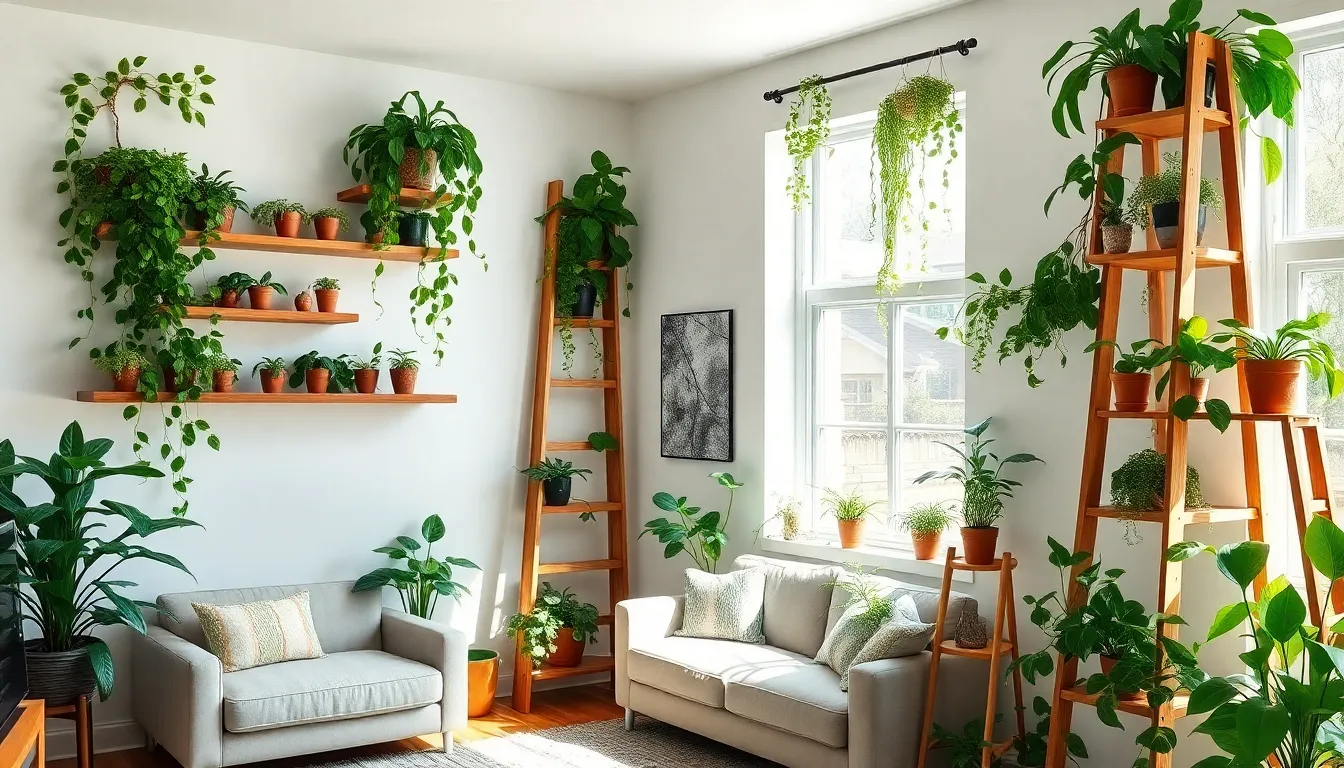
Strategic shelving transforms ordinary vining plants into architectural features that elevate your entire space. We’ll explore three innovative approaches that maximize visual impact while providing optimal growing conditions for your trailing beauties.
Floating Shelf Arrangements
Floating shelves create the illusion of suspended gardens throughout your home, allowing vines to drape naturally without visible support structures. Mount multiple shelves at varying heights to establish a cascading effect that draws the eye upward and makes rooms feel more spacious. Position your Pothos or Philodendron on these sleek platforms where their vines can trail elegantly down the edges, creating stunning living curtains against blank walls.
Stagger shelf placement rather than aligning them vertically to add visual interest and prevent your display from looking too rigid. Space shelves 18-24 inches apart to give trailing vines room to develop their full draping potential. Install shelves near windows where indirect light can nourish your plants while the natural illumination highlights the beautiful texture of cascading foliage.
Ladder Plant Stand Ideas
Ladder style plant stands offer multiple tiers that accommodate various vining plants while maintaining a compact footprint in your room. These vertical structures encourage natural upward growth as vines can intertwine along the rungs or cascade freely from each level. Choose wooden ladders for a rustic aesthetic or sleek metal designs for contemporary spaces.
Position climbing varieties like String of Pearls on upper rungs where they can trail downward through the ladder structure. Place larger containers with established vines on lower levels to create a foundation of lush greenery. Rotate your ladder stand occasionally to ensure all plants receive equal light exposure and maintain balanced growth patterns.
Corner Plant Tower Concepts
Corners provide untapped vertical space perfect for creating dramatic plant towers that soften harsh architectural angles. Build tiered corner shelving units that expand upward rather than outward, maximizing your growing space without encroaching on valuable floor area. These tower arrangements work especially well with multiple small pots containing different vining varieties.
Create visual hierarchy by placing your most established trailing plants at the top where their vines can cascade down multiple levels. Mix different textures and colors by combining plants like String of Hearts with its delicate trailing stems alongside bold Philodendron varieties. Install grow lights above your corner tower if natural light is limited, ensuring all levels receive adequate illumination for healthy vine development.
Install Creative Hanging Solutions Throughout Your Home
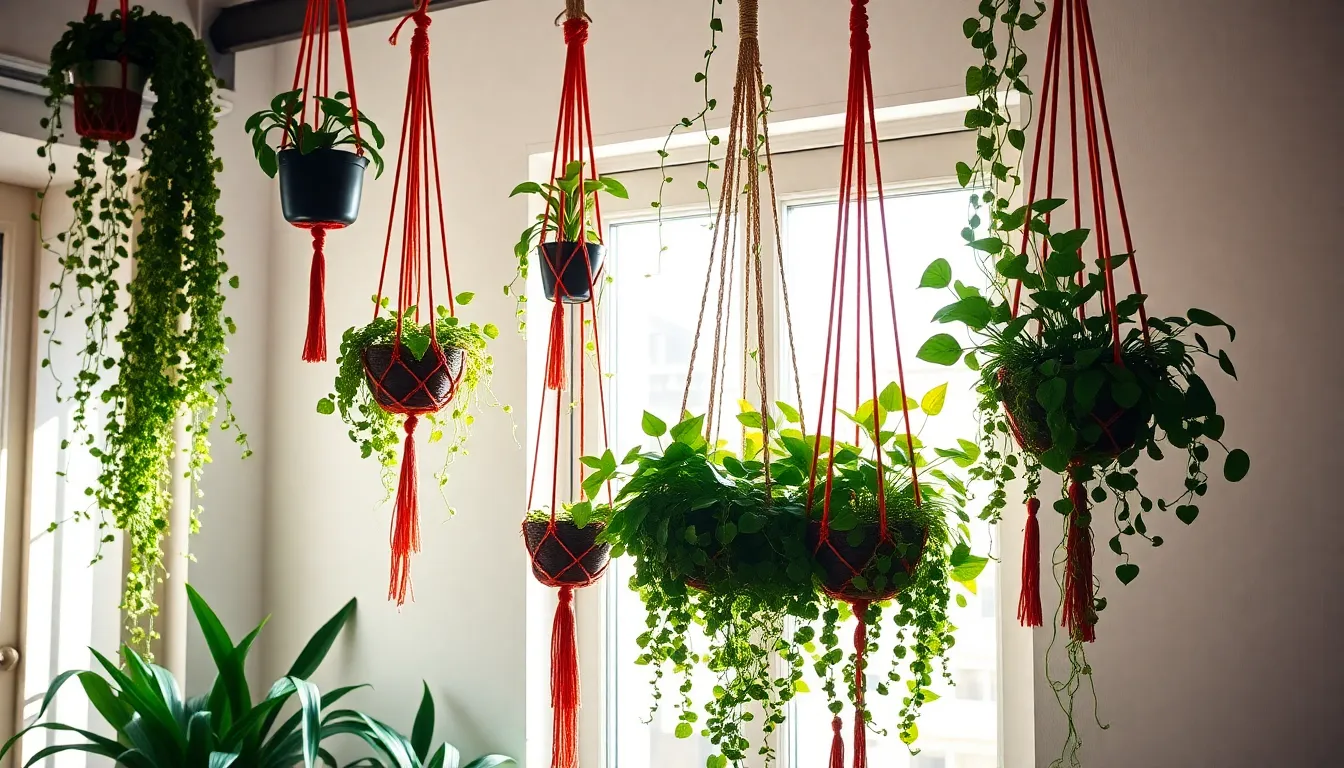
Creative hanging systems transform empty vertical spaces into stunning displays while keeping floors clear for daily activities. We’ll explore three essential techniques that maximize your vining plants’ natural beauty.
Macrame Plant Hanger Placement
Macrame plant hangers add bohemian charm while showcasing trailing plants like pothos, philodendrons, or string of hearts. These handcrafted holders create elegant draping effects that draw attention upward and save valuable floor space throughout your home.
Position macrame hangers at varying heights to create visual depth and interest. We recommend placing them in corners where vines can cascade freely without obstruction. Living rooms benefit from multiple hangers clustered at different levels, while bedrooms work best with single statement pieces near windows.
Choose macrame designs that complement your existing decor style. Natural cotton rope suits minimalist spaces, while colorful cord options enhance eclectic rooms. Consider the plant’s mature size when selecting hanger lengths to ensure adequate growth space.
Ceiling Hook Installation Tips
Installing ceiling hooks requires proper anchoring to support your plants’ weight safely and securely. Choose hooks rated for at least twice your plant’s expected mature weight, including soil and water content.
Locate ceiling joists using a stud finder before drilling to ensure maximum stability. Mark your desired positions with a pencil, spacing hooks appropriately to allow vines to grow without tangling. Pre drill pilot holes to prevent ceiling damage during installation.
Consider swivel hooks for plants that benefit from rotation for even light exposure. We suggest installing hooks 8 to 12 inches from walls to provide adequate clearance for trailing growth. Test each hook’s stability before hanging plants by applying gentle pressure.
Window Suspension Systems
Window suspension systems maximize natural light exposure that most vining plants require for healthy growth. These setups enable multiple plants to thrive in bright, indirect sunlight while creating stunning living curtain effects.
Install tension rods or wire cables across window frames to support hanging baskets or individual pots. Space plants to prevent overcrowding while ensuring each receives adequate light penetration. Consider adjustable systems that accommodate seasonal plant rotation.
Position sun loving vines like maidenhair vine or jade trailing plants closest to windows for optimal light exposure. We recommend using clear or translucent hanging containers to maintain window transparency while showcasing root systems. Filter intense direct sunlight with sheer curtains to prevent leaf burn.
Style Different Rooms With Targeted Vining Plant Ideas
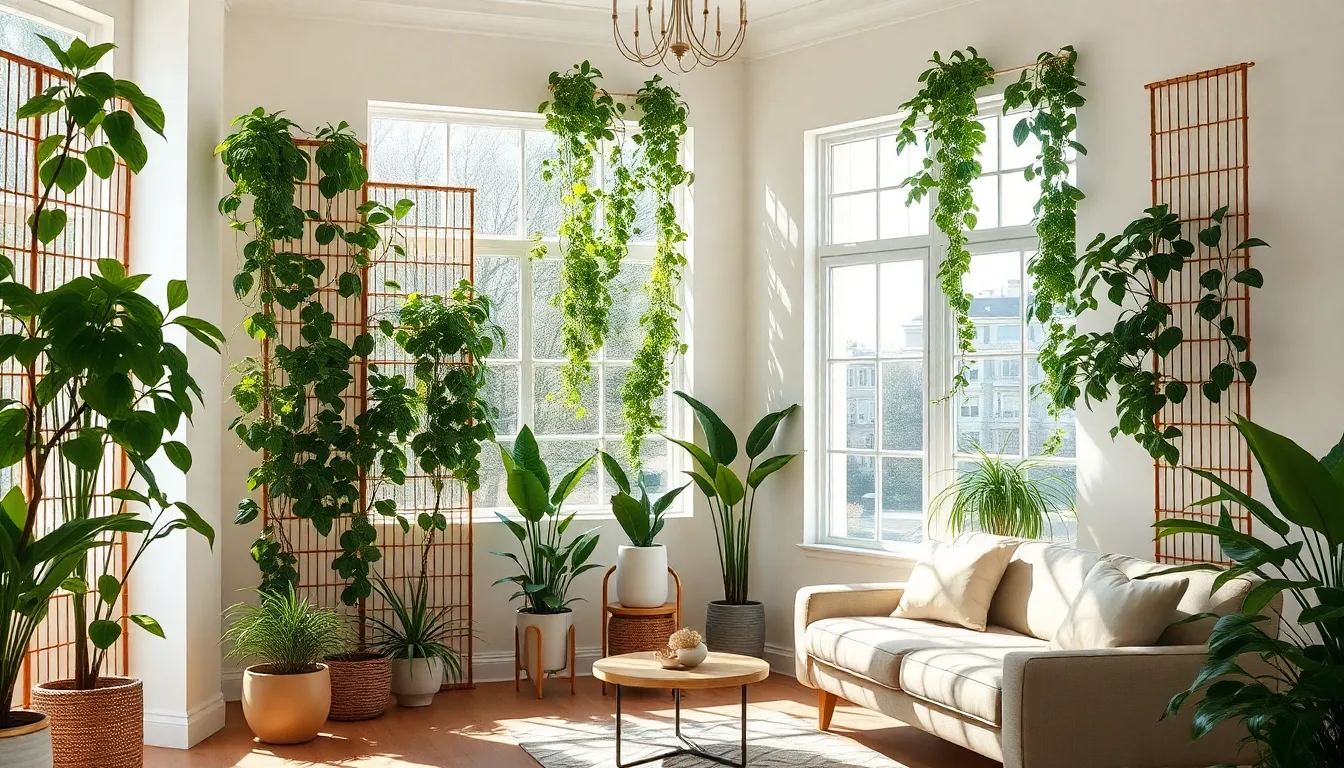
We’ll transform each room in your home by selecting vining plants that complement exact environments and functional needs. Different spaces require different approaches to maximize both beauty and plant health.
Living Room Statement Pieces
Pothos and philodendrons create stunning focal points when trained up moss poles or decorative trellises in living rooms. Training these vigorous climbers vertically produces dramatic, lush displays that draw the eye upward and complement your existing decor. We recommend using attractive support structures like bamboo poles or copper trellises to enhance the aesthetic appeal while providing necessary climbing support.
Proper sunlight and nutrient rich soil keep these statement plants thriving in your main living space. Position them near windows with bright, indirect light and maintain organic, well draining soil to support their climbing growth. Regular fertilization during active growth seasons ensures these plants develop the full, cascading foliage that makes them such impressive room features.
Bedroom Air-Purifying Options
Heartleaf philodendrons and pothos varieties excel at improving indoor air quality while adding peaceful greenery to bedroom spaces. These air purifying vines prefer indirect light conditions and moderate watering schedules that align perfectly with bedroom environments. We suggest placing them on shelves or in hanging planters where their trailing habit can soften the room’s atmosphere.
Organic, nutrient rich soil maintenance ensures these bedroom plants continue their air cleaning benefits throughout the night. Keep watering consistent but avoid overwatering, as bedroom plants often receive less direct airflow than those in common areas. Their gentle cascading growth creates a calming visual effect that promotes restful sleep.
Kitchen Herb Vine Integration
Thyme, oregano, and mint varieties provide both decorative appeal and fresh ingredients when grown as trailing kitchen vines. These vining herbs thrive in bright, indirect light near kitchen windows and offer immediate access to fresh seasonings during cooking. Train them on small stakes or allow natural cascading from hanging pots for a practical yet beautiful kitchen feature.
Regular watering and proper positioning keep these edible vines productive and healthy in kitchen environments. Place them within easy reach of your cooking area but away from direct heat sources like stoves or ovens. We recommend rotating herb containers weekly to ensure even growth and prevent leaning toward light sources.
Bathroom Humidity-Loving Species
Pothos, philodendrons, and English ivy flourish in the moist, low light conditions that characterize most bathroom spaces. These humidity loving species naturally thrive in bathroom environments where other plants might struggle with inconsistent lighting and moisture levels. Use moss poles or small trellises to mimic their natural climbing habitats and encourage upward growth.
Frequent misting and damp support structures help these bathroom vines reach their full potential in humid conditions. Keep moss poles slightly moist and provide occasional fertilization during growing seasons to maintain plant vigor. We suggest positioning them near windows when possible, but these adaptable plants can succeed even in windowless bathrooms with artificial lighting.
Maintain Healthy Growth With Proper Care Techniques
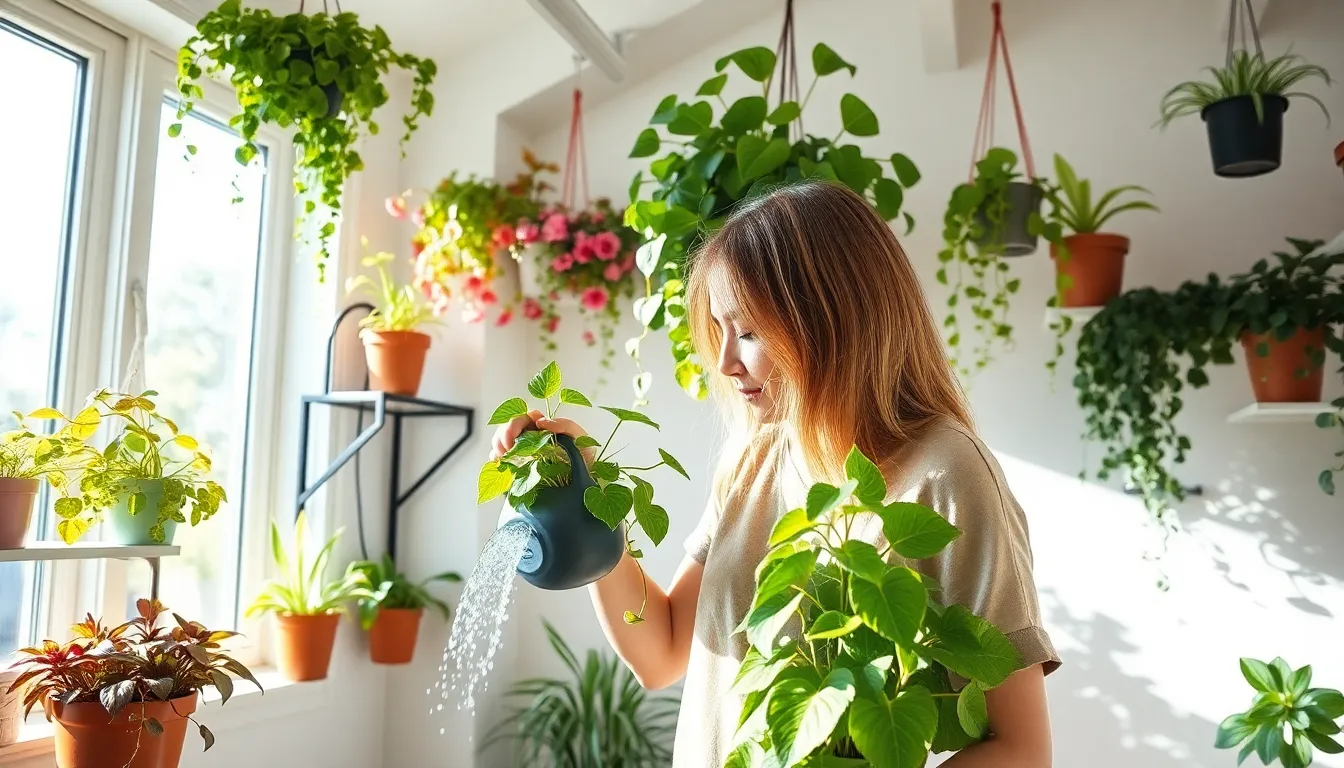
Proper care ensures our indoor vining plants thrive and create the stunning displays we’ve envisioned. Building upon the placement strategies we’ve discussed, maintaining healthy growth requires attention to three essential care elements.
Watering Schedule Guidelines
Most indoor vining plants tolerate some neglect but perform best with consistent watering according to their species-exact needs. We recommend allowing the soil to dry slightly between watering sessions since most vines don’t like soggy roots. Overwatering poses a greater threat than underwatering for these resilient plants.
Seasonal adjustments help us optimize our watering routine throughout the year. During cooler months or in dry indoor air conditions, we need to water less frequently. Summer months or humid environments may require more frequent watering sessions to maintain proper soil moisture levels.
Monitor soil moisture by inserting our finger about one inch deep into the potting mix. Dry soil indicates it’s time to water, while damp soil suggests we should wait another day or two before the next watering session.
Light Requirements Assessment
Indirect light works best for most vining houseplants, though they can tolerate low light conditions surprisingly well. Some varieties benefit from a few hours of direct sunlight, ideally from a south-facing window. Position plants where they receive bright, filtered light for optimal growth and vibrant foliage colors.
Insufficient light can hamper a vine’s ability to climb or photosynthesize effectively, leading to leggy growth and pale leaves. We notice healthy vines produce fuller foliage and stronger climbing habits when they receive adequate lighting throughout the day.
Rotate plants weekly to ensure even light exposure on all sides. This practice prevents lopsided growth and encourages balanced development of both trailing and climbing portions of our vining plants.
Pruning and Training Methods
Regular pruning keeps vines manageable while encouraging bushier growth and maintaining attractive shapes. Using sterilized pruners or snips, we cut back long or leggy vines to promote new growth from lower nodes. These pruned cuttings offer excellent opportunities for propagating our favorite plants.
Training involves securing vines to supports like trellises, moss poles, or wire frames using gentle ties or clips. We place support structures in the soil during repotting to avoid damaging established root systems. Tropical vines especially appreciate humidity, so misting or pebble trays help simulate their natural environment.
Guide climbing vines upward by wrapping them around supports or securing them with soft plant ties. Some vines can be trained on wire frames, trellises, or along walls using clear hooks for aesthetic displays that complement our room’s design scheme.
Troubleshoot Common Vining Plant Problems
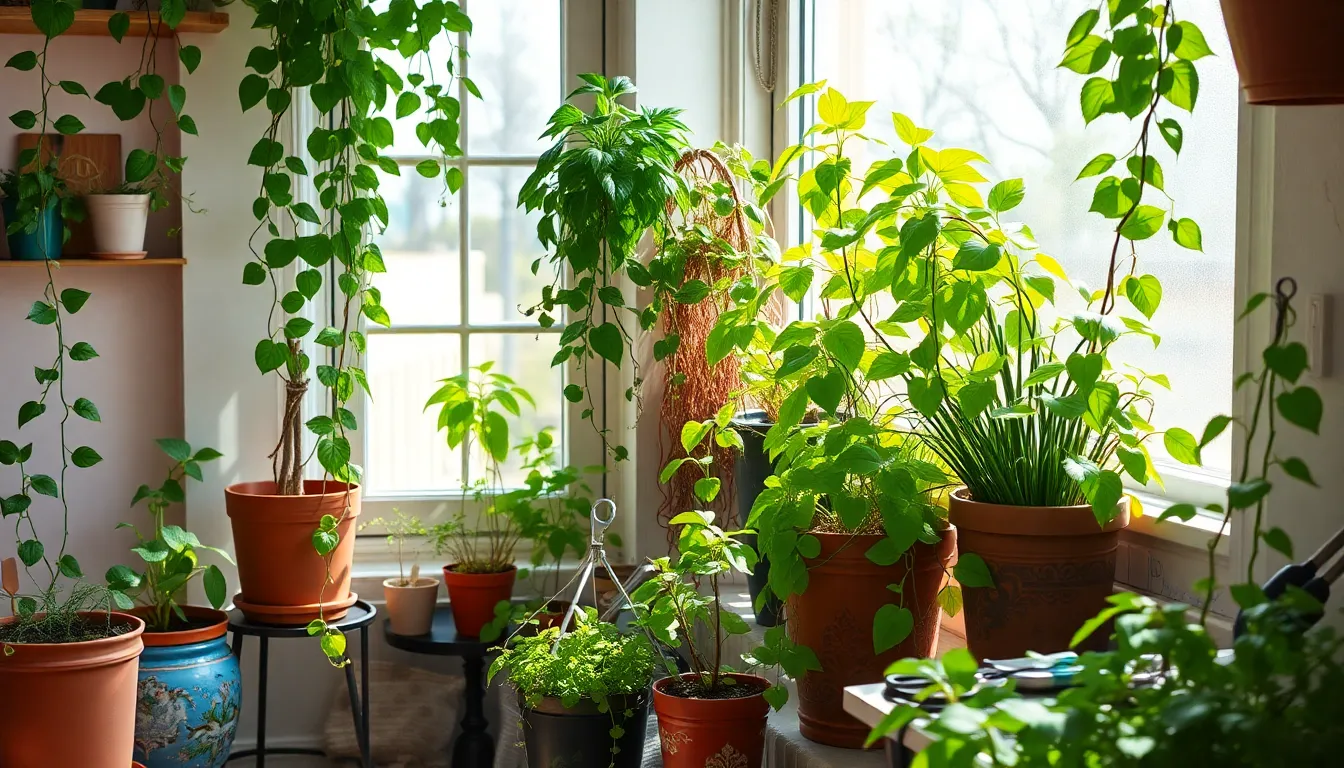
Even the most gorgeous indoor vining displays can face challenges that threaten their beauty and health. Let’s explore practical answers to keep your climbing and trailing plants thriving.
Pest Prevention Strategies
Regular inspections help us catch pest problems before they damage our vining plants. We should examine leaves weekly for spider mites, aphids, and mealybugs that commonly target indoor vines.
Good air circulation prevents pest infestations from taking hold in our plant spaces. Positioning fans near dense foliage areas and spacing plants appropriately reduces humidity buildup that attracts unwanted insects.
Overwatering creates ideal conditions for pests to multiply rapidly. We maintain proper watering schedules and ensure excellent drainage to eliminate moisture-loving pest habitats.
Gentle insecticidal soaps work effectively as both preventive treatments and active answers when pests appear. Neem oil applications every two weeks during growing season protect our vines from common indoor plant pests.
Cleaning leaves removes dust accumulation and potential pest eggs hiding in dense trailing foliage. We wipe down leaves monthly with damp cloths to maintain plant health and appearance.
Yellowing Leaf Answers
Overwatering stands as the primary cause of yellow leaves in indoor vining plants. We check soil moisture levels before each watering session to prevent waterlogged conditions that damage root systems.
Poor drainage compounds overwatering issues and accelerates leaf yellowing. Adding drainage holes to decorative pots and using well-draining soil mixes prevents water accumulation around vine roots.
Nutrient deficiencies trigger yellowing when plants can’t access essential minerals for healthy growth. We fertilize our vining plants regularly during growing season with balanced liquid fertilizers or seaweed-based nutrients.
Insufficient light exposure causes leaves to yellow and drop from climbing or trailing vines. Moving plants closer to bright, indirect light sources or supplementing with grow lights restores healthy green foliage.
Natural aging affects older leaves at the bottom of vine stems. We remove yellowing mature leaves to redirect plant energy toward new growth and maintain attractive vine displays.
Root Bound Plant Management
Circling roots signal when our vining plants need larger containers for continued healthy growth. We examine root systems annually by gently removing plants from their current pots.
Repotting every 1-2 years into slightly larger containers prevents root restriction issues. Fresh, organic, nutrient-rich soil provides essential minerals while giving roots room to expand naturally.
Support structures require installation before placing root bound plants back into new containers. We insert moss poles or trellises first to avoid damaging newly transplanted root systems during support installation.
Tight root masses need gentle loosening before repotting to encourage outward growth. We carefully tease apart circled roots and trim any damaged or rotted sections with clean pruning shears.
Water uptake improves dramatically after addressing root bound conditions in our vining plants. Previously stressed plants show renewed vigor within weeks of receiving adequate root space and fresh growing medium.
Conclusion
We’ve shared everything you need to transform your home with stunning vining plants that’ll make your friends green with envy. From dramatic vertical gardens to clever hanging answers these living decorations offer endless possibilities for every room in your house.
Remember that success with indoor vining plants comes down to understanding their basic needs and choosing varieties that match your lifestyle. Whether you’re a beginner starting with low-maintenance pothos or ready to tackle more ambitious climbing displays the key is starting small and building your confidence.
Your vertical spaces are waiting to be transformed. With the right plants proper support structures and consistent care you’ll create Instagram-worthy displays that purify your air and elevate your home’s aesthetic appeal.
Frequently Asked Questions
What are the best indoor vining plants for beginners?
Golden pothos, spider plants, and heartleaf philodendrons are excellent choices for beginners. These plants are extremely forgiving, require minimal care, and thrive in various light conditions. Pothos varieties like marble queen and jade pothos offer beautiful foliage patterns while tolerating occasional watering mistakes. Spider plants are particularly rewarding as they produce “babies” that can be easily propagated.
How do vining plants help purify indoor air?
Vining plants like pothos and philodendrons actively remove toxins from indoor air through their natural filtration process. They absorb harmful chemicals such as formaldehyde and benzene through their leaves and roots, converting them into harmless compounds. This makes them particularly beneficial for bedrooms and living spaces where air quality directly impacts health and comfort.
What’s the best way to train vining plants to climb?
Use moss poles, trellises, or wooden stakes as support structures. Gently secure vines to supports using soft plant ties or clips, avoiding tight binding that could damage stems. For plants like Monstera deliciosa, position aerial roots against the support to encourage natural climbing. Regular training sessions help guide growth direction and create fuller, more attractive displays.
How often should I water my indoor vining plants?
Most vining plants prefer soil that dries slightly between waterings, typically every 1-2 weeks depending on humidity and season. Check soil moisture by inserting your finger 1-2 inches deep – water when it feels dry. Overwatering is more harmful than underwatering, so err on the side of caution and establish a consistent schedule based on your plant’s specific needs.
Can vining plants survive in low-light conditions?
Yes, many vining plants adapt well to low-light environments. Pothos, philodendrons, and English ivy are particularly tolerant of dimmer conditions, making them perfect for bathrooms, offices, or north-facing rooms. While growth may slow in low light, these plants will still thrive and provide beautiful foliage displays without requiring bright, direct sunlight.
How do I prevent pests on my vining plants?
Regular inspection is key to pest prevention. Check leaves weekly for signs of spider mites, aphids, or scale insects. Maintain good air circulation around plants and avoid overwatering, which attracts pests. If pests appear, use gentle insecticidal soap or neem oil treatments. Quarantine new plants for two weeks before introducing them to your collection.
What causes yellowing leaves on vining plants?
Yellowing leaves typically result from overwatering, poor drainage, or nutrient deficiencies. Ensure pots have drainage holes and use well-draining potting mix. Allow soil to dry between waterings and consider feeding with balanced liquid fertilizer monthly during growing season. Some yellowing of older leaves is natural, but widespread yellowing indicates care adjustments are needed.
How can I use vining plants as natural room dividers?
Train climbing plants on tall trellises or room divider screens to create living partitions in open floor plans. Plants like pothos or philodendrons can be grown on freestanding supports, providing privacy while maintaining airflow. This solution works particularly well between living and dining areas, creating distinct spaces without solid walls blocking natural light.
When should I repot my vining plants?
Repot when plants become root-bound, typically every 2-3 years or when roots circle the pot’s bottom or emerge from drainage holes. Signs include water running straight through soil, stunted growth, or roots visible on the surface. Choose a pot only 1-2 inches larger than the current one, and refresh with quality potting mix to encourage healthy growth.
What are the best rooms for different vining plants?
Living rooms suit pothos and philodendrons trained on decorative supports for dramatic focal points. Bedrooms benefit from air-purifying heartleaf philodendrons and pothos for better sleep quality. Kitchens are perfect for trailing herbs like thyme and mint that serve dual purposes. Bathrooms accommodate humidity-loving species like English ivy and pothos that thrive in moist, low-light conditions.

